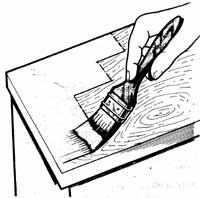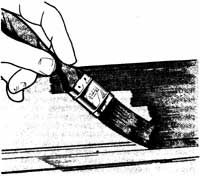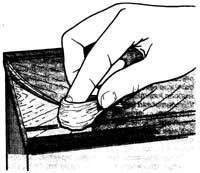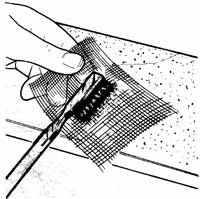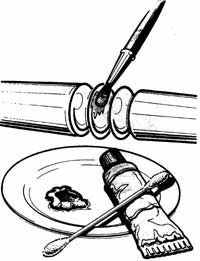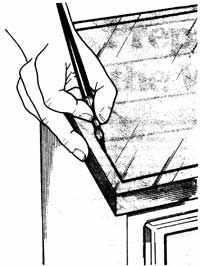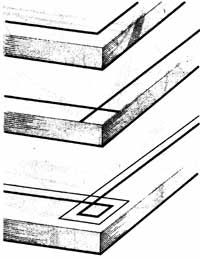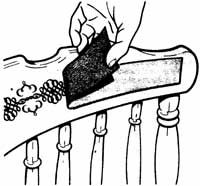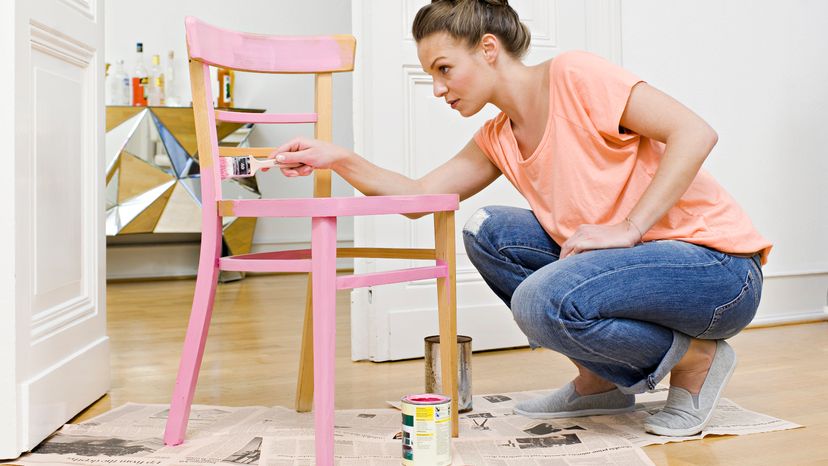
You can decorate newly finished furniture, refurbish an old piece without stripping it, or add distinction to an inexpensive unfinished piece by adding a special-effect touch. You have many options to choose from.
You can apply an enamel finish to hide many surface flaws. Antique glazing or flyspecking will create an aged or worn wood look. Wax gilding adds a gold color to a furniture's shine. Stencils, paint stripes and decals are simple and economical ways to add decoration to almost any finish. Use your imagination and the step-by-step instructions mentioned in this article to create any special effect you prefer.
Advertisement
Before you begin any special-effect technique, make sure your furniture surface is clean and smooth. And make sure the materials you want to use are compatible with the finish already on the piece. This is especially important with lacquer finishes. One common choice for decorating furniture is applying an enamel finish.
Enameling
Unlike clear finishes, enamel can be used over an old finish on wooden furniture. It is tough, attractive, and easy to take care of. It covers a lot of flaws -- poor-quality or uninteresting wood, badly stained surfaces, and pieces made with very different types of wood can all be rescued with a coat of bright enamel. Used over bare wood or over an old finish, enamel can create a striking accent piece.
Types of Enamel
Where furniture is concerned, enamel should never be confused with paint. Paint consists of pigments in an application vehicle or medium. Good enamel consists of pigments in a varnish, lacquer, or oil base. While enamel is as tough as varnish, paint produces a soft finish, and is not recommended for use on furniture. Oil-based enamel is generally superior to the latex type.
Enamel is available in high-gloss, semigloss, and flat or matte forms. If you're enameling a piece of furniture as an accent for a room, you may want a shiny finish, but most fine enameled furniture has a satin finish, not high-gloss. Buy enamel in stock colors, or have it mixed at the paint store.
Special Requirements
Finished surfaces to be enameled must be sealed with thinned shellac. Before enamel is applied, all surfaces should be undercoated. Shiny enamel emphasizes flaws, so surfaces to be covered with this type must be very smooth. Enamel cannot be used over wax.
Unless a piece of furniture has intricate carvings already clogged by the old finish, stripping or removing the old finish is not required before enamel is applied. To prepare a finished piece of furniture for enameling, sand it to remove any obvious flaws and chip marks. The surface must be smooth, but it isn't necessary to remove the old finish completely. Clean the sanded wood thoroughly with a tack cloth, and apply a sealer coat of thinned shellac. Let it dry completely and sand the piece lightly with grade 7/0 sandpaper. Remove the sanding debris with a tack cloth. To prepare an unfinished piece of furniture, sand and seal the wood with any finish application, and clean it with a tack cloth.
Application Techniques
Wooden furniture to be finished with enamel must be properly sanded, coated with a filler finish to even out the open pores, and coated with a sealer finish to create a smooth surface. (For guidelines on how to sand and seal furniture, click here.) Finished surfaces must be sanded and sealed only. Before applying enamel, clean the piece of furniture thoroughly with a tack cloth.
Before applying the enamel, you must undercoat the piece of furniture; commercial enamel undercoater is available. This undercoater is usually white; use it white or have it tinted to match the enamel. The undercoat should never be darker than the enamel.
Apply the undercoat with a clean, good-quality brush; make sure the undercoat is thoroughly mixed. Brush the undercoat smoothly and evenly along the grain of the wood, flowing it on to cover the surface completely. Carefully smooth the surface to even out any thick spots. Brush marks will almost disappear as the undercoat dries.
Let the undercoat dry for at least three days, or as directed by the manufacturer; then lightly sand the undercoated surfaces with grade 7/0 sandpaper. Remove all sanding debris with a tack cloth.
When the undercoat is complete, apply the enamel. Use a clean, good-quality brush, of the type specified by the enamel manufacturer; mix the enamel thoroughly but gently. Apply the enamel with long, smooth, even strokes, laying it on along the grain or length of the wood in strips the width of the brush. Use enough enamel to flow smoothly onto the surface, but not so much that you leave thick spots.
After laying on an even coat of enamel in strips, apply more enamel across the grain or width of the wood to level and even the surface. The enamel should be as even as possible, with no thick or thin spots, but as with varnish, a thin coat is better than a thick one. Thick coats of enamel dry extremely slowly, and tend to stay soft for a long time.
To finish each surface, tip off the enamel along the grain or length of the wood, using an almost dry brush. Holding the brush at a slight angle to the surface, very lightly stroke the surface of the enamel to remove brush marks and even the surface. Smooth the entire enameled surface, working in strips along the grain or length of the wood. As you work, pick off dust and lint with a lint picker. Brush marks will disappear as the enamel dries.
On vertical surfaces, enamel is likely to sag or run. Work with a fairly dry brush, applying enamel from dry to wet surfaces. As you finish each surface, carefully inspect it for runs and sags. With the brush in a tipped position, and moving the brush as you come onto the surface with the bristles, tip the finish. Keep the stroke in motion as you come through the sag or run and as the tip of the brush leaves the surface. By keeping the brush in motion before, during, and following the tipping, you will avoid brush marks. Watch the enamel carefully as it dries; sags and runs are especially liable to occur after the enamel has set for 10 to 15 minutes. Tip off sags and runs immediately when you spot them.
Enamel must be applied carefully to prevent thick spots. At outside corners, work from the flat surface toward the corner; lift the brush as it nears the corner and before it flips down over the edge. This prevents a buildup of enamel along the edge. At inside corners, work an inch or two away from the corner; then brush the enamel into the corner, tip it off, and leave it alone. This method prevents buildup on many flat-surface brushings. Spots that tend to hold enamel like tiny potholes should be coated just once with enamel and tipped just once with the brush. Repeated tipping will leave a bulge.
Brush lengthwise along rungs, spindles, and other turnings. On carved moldings, apply the finish to the carvings first with a fairly dry brush; then finish the flat surfaces with the tip of the brush. Finally, with a very dry brush, go over the carvings and then the flats, leveling the finish and removing any fat edges, sags, or runs. On raised panel doors, finish the panels first and then move onto the flat framing. The finish will build up at the miters in the frame where they meet the panel; remove the excess with a very dry brush, working from the corner out.
Drying and Recoating
Let the enamel dry for several days, or as directed by the manufacturer. Then lightly sand the surface with grade 7/0 sandpaper and a padded sanding block, and clean the piece of furniture thoroughly with a tack cloth. Apply a second coat of enamel, as above, and let it dry completely.
Enamel can be finished in several ways. For a tough, shiny surface, apply a third coat of enamel, as above; sand the second coat lightly before applying more enamel. Or let the piece of furniture dry for at least a month, and then apply a coat of paste wax and buff it to a shine.
Enamel is a common base used for antique glazing furniture. Check out the next section for guidelines on when and how to add an aged or colored look to your piece.
